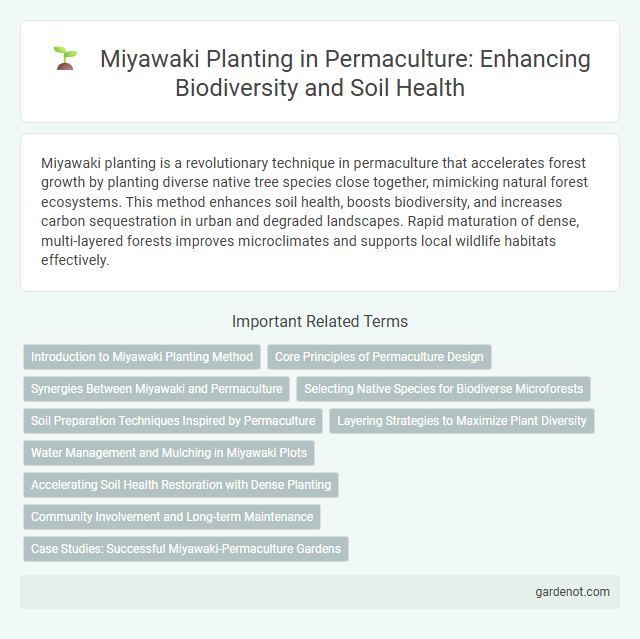Miyawaki planting is a revolutionary technique in permaculture that accelerates forest growth by planting diverse native tree species close together, mimicking natural forest ecosystems. This method enhances soil health, boosts biodiversity, and increases carbon sequestration in urban and degraded landscapes. Rapid maturation of dense, multi-layered forests improves microclimates and supports local wildlife habitats effectively.
Introduction to Miyawaki Planting Method
Miyawaki planting method involves creating dense, native forests by planting a variety of indigenous species close together, replicating natural forest ecosystems. This technique accelerates biodiversity restoration, enhances soil health, and sequesters carbon efficiently within a few years. Developed by Japanese botanist Akira Miyawaki, it fosters rapid growth and resilience in urban and degraded environments.
Core Principles of Permaculture Design
Miyawaki planting exemplifies permaculture design by emphasizing native species, biodiversity, and natural ecosystem restoration to create resilient forests. The core principles of permaculture, such as observing and interacting with local environments, valuing diversity, and using small-scale intensive systems, are integral to this method. By mimicking natural forest succession and promoting multilayered plant structures, Miyawaki plantations enhance soil health, water retention, and habitat complexity.
Synergies Between Miyawaki and Permaculture
Miyawaki planting enhances permaculture by accelerating forest ecosystem development through dense, native species planting that fosters biodiversity and soil health. The rapid canopy formation in Miyawaki forests complements permaculture's soil regeneration and water conservation techniques, creating resilient microclimates. Integrating Miyawaki's natural succession with permaculture design principles maximizes ecological benefits and sustains long-term agroforestry productivity.
Selecting Native Species for Biodiverse Microforests
Selecting native species for Miyawaki planting enhances ecosystem resilience by promoting local biodiversity and supporting native wildlife. These species adapt well to the regional climate and soil, ensuring rapid growth and minimal maintenance in creating dense, multi-layered microforests. Incorporating a diverse mix of trees, shrubs, and groundcovers native to the area optimizes carbon sequestration, soil health, and habitat restoration.
Soil Preparation Techniques Inspired by Permaculture
Miyawaki planting employs soil preparation techniques inspired by permaculture principles, emphasizing the creation of nutrient-rich, well-aerated soil through layers of organic matter and local microbial inoculants. The method involves mixing native topsoil with compost, mulch, and biochar to enhance moisture retention and promote biodiversity. This approach revitalizes degraded land by mimicking natural forest ecosystems, resulting in resilient, self-sustaining vegetation growth.
Layering Strategies to Maximize Plant Diversity
Miyawaki planting employs strategic layering by integrating multiple plant species across various vertical strata, including canopy, sub-canopy, shrub, and ground cover layers, to replicate natural forest ecosystems. This method enhances biodiversity by promoting complex root interactions, optimizing space utilization, and creating microhabitats that support diverse flora and fauna. The multilayered structure increases soil fertility and moisture retention, accelerating forest growth and resilience in permaculture landscapes.
Water Management and Mulching in Miyawaki Plots
Miyawaki planting enhances water retention through strategic mulching techniques that reduce evaporation and improve soil moisture levels. Using organic mulch layers, such as leaf litter and compost, stabilizes temperature and fosters microbial activity essential for root development. Effective water management in Miyawaki plots minimizes irrigation needs and supports resilient, dense forest ecosystems suited to local climates.
Accelerating Soil Health Restoration with Dense Planting
Miyawaki planting accelerates soil health restoration by using dense, native vegetation layers that rapidly increase biodiversity and organic matter. This method enhances microbial activity and nutrient cycling, promoting robust soil structure and water retention. Dense planting also prevents erosion and fosters resilient ecosystems that regenerate soil fertility faster than conventional reforestation techniques.
Community Involvement and Long-term Maintenance
Miyawaki planting fosters strong community involvement by engaging local residents in the planting and nurturing of native forests, enhancing environmental stewardship and social cohesion. This method promotes long-term maintenance through collaborative care, ensuring the young forests are regularly monitored, watered, and protected from invasive species. Community-led management not only sustains forest growth but also creates lasting ecological and social benefits in urban and rural areas.
Case Studies: Successful Miyawaki-Permaculture Gardens
Miyawaki planting techniques have been successfully integrated with permaculture principles in diverse case studies, demonstrating rapid forest regeneration and enhanced biodiversity within urban spaces. Projects like the Shubhankar Forest in Mumbai and the Miyawaki mini-forests in Chennai illustrate how native species clustering creates resilient ecosystems that improve soil health and microclimates. These successes highlight the potential of combining Miyawaki's native afforestation with permaculture's sustainable land-use design for long-term ecological and social benefits.
Miyawaki planting Infographic

 gardenot.com
gardenot.com